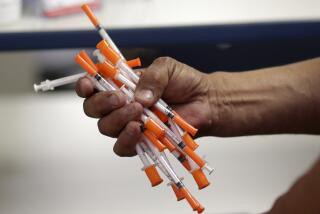Tainted Candy No Longer a Halloween Worry
A decade ago, sending Halloween treats under the hospital X-ray machine seemed destined to become as much a part of the holiday tradition as jack-o’-lanterns and candy corn.
Instead, the practice has quietly faded. Orange County hospitals that just a couple of years ago checked for razor blades in apples and pins in candy bars won’t offer the service this weekend, citing a lack of community participation.
The virtual elimination of the X-ray machine at Halloween comes in the wake of changes in how the holiday is celebrated. The growth of organized events--from school parties to church- and shopping mall-sponsored festivals--has been fueled in part by parents haunted by fears that children let loose on the neighborhood streets could come home with tainted candy.
As a result, experts say, parents feel more secure and have less need to send their children’s sugary loot through the X-ray machine.
“When I first started, there was all sorts of homemade stuff, brownies and popcorn balls and cookies,” said Rick Lind, a chiropractor in Orange who has X-rayed candy for concerned parents for 18 years. “Now it’s all wrapped candy.”
This year, for the first time, Lind has decided not to offer the X-raying. Since the holiday falls on Saturday, Lind doubts anyone would take him up on the service--although he is certain most parents will carefully check their children’s Halloween candy no matter the source.
Over the years, Lind said he’s discovered several foreign objects in candy, including one pin in a candy bar. But for the most part, the candy he examined appeared perfectly safe, he said.
Myron Orleans, a professor of sociology at Cal State Fullerton, said the disappearance of X-raying doesn’t mean parents have dropped their guard.
“Mostly what parents do is chaperon their kids from door to door, always hovering in the background, going only to selected people they believe wouldn’t harm their children,” Orleans said.
Orleans and others who have studied reports of candy tampering concluded that the fear far outweighed the tiny risk. But he said many believe such stories and don’t want to take any chances.
Once-common homemade Halloween treats such as caramel corn and candied apples have all but vanished. Most parents today will accept only store-bought candy bars and wrapped confections, which police and organizations such as the American Red Cross have long recommended for safety reasons.
But until recently, hundreds of Orange County families a year have gone a step further and put candy under radiation--even though hospitals reported finding little amiss.
Anaheim Police Sgt. Joe Vargas labels tales of tampered candy as “urban myth” but admits that his family--like many others--has abandoned old-style Halloween.
“We used to see hordes of children trick-or-treating. Now there are only a few,” Vargas said.
The use of X-rays dates to the late 1960s when rumors of razor blades in apples in New Jersey and Canada began to circulate. The practice reached its peak in the early 1980s when seven people were killed by poisoned Tylenol in Chicago’s suburbs--murders that heightened fears about tainted products--and continued into the 1990s.
Well into this decade, Orange County parents could easily find a place to have their children’s candy X-rayed. But in recent years, hospital administrators said few showed up. Many hospitals in Los Angeles County also have dropped the candy X-raying, though a few still offer the service.
Vargas, a 19-year police veteran, said he’s not surprised the practice has waned: He’s never heard of a reported case of candy tampering in the area. Still, Vargas does not permit his two children to trick-or-treat alone, although he said he is more worried about possible accidents than he is about bad candy from strangers.
Instead, the family will head to a Harvest Celebration at his church in Corona and then, only if time permits, knock on the doors of a few close friends.
But others say concerns about safety--while legitimate--are robbing their children of memories their parents cherish.
Jerry Owyang, 45, remembers planning a route through his San Diego neighborhood with no parents in tow.
“We wanted to hit all the apartment complexes where we could knock on as many doors as possible,” said Owyang, who is now youth minister at United Methodist Church in Garden Grove. “I wish my kids could do the same thing, but I think there is just more danger in society.”
His church is sponsoring a Harvest Festival where children will go classroom to classroom knocking on doors--a simulation of the Halloweens he remembers.
Some suburban neighborhoods have recently seen a resurgence in traditional trick-or-treating. Orleans, the Cal State Fullerton sociologist, said this trend is encouraging because it teaches children the importance of being part of a larger community.
Even so, many parents say times have changed and frequently mention the rumors of Halloween candy-tampering as proof.
“Too much goes on today in society,” said Carolyn Jamison, 56, a Santa Ana community center director, “People put razors in apples. Things are just different. That’s why I stopped my kids from going out.”
Jamison said the crowd at the center’s annual Halloween party grows every year, just as the number of parents seeking candy X-raying drops.
Hospital administrators say they were able to discontinue the X-ray services without community protest. The situation suited many hospitals just fine because the examinations could never offer complete peace of mind for parents.
“Honestly, things can be injected into the candy that can’t be detected on the X-ray,” said Kathleen O’Brien at Fountain Valley Regional Hospital, which stopped offering the checks several years ago. “It gives people a false sense of security.”
But some parents say X-raying candy was always too extreme.
“That’s scary stuff,” said Madeline Lee, of La Canada Flintridge, adding she would never take her two young boys to a hospital to watch their candy examined. “You have to teach awareness to these kids, but they don’t need to know all the realities of the world at age 5.”
Times correspondent Jason Kandel contributed to this report.
* DAY OF THE DEAD: Mexico’s Nov. 2 holiday, honoring deceased loved ones, is becoming a crossover event. B1
* SILVER SCREEN PROSTHETICS: Dozens of L.A. firms make fake body parts for movies. But they face stiff competition. C1
More to Read
Sign up for Essential California
The most important California stories and recommendations in your inbox every morning.
You may occasionally receive promotional content from the Los Angeles Times.










